
Back to home page
Back to audio electronics page
Three steps are needed:

The following formulas values are in:
The AC output voltage of a transformer (the specs of the manufacturer) is the nominal
voltage. It corresponds to the DC voltage that would make the same effect on a resistor
(heating).
As an AC voltage is usually a sine-wave, the peaks are much higher than the nominal
voltage (Unom*1.414).
The average voltage corresponds to the DC voltage that has the same "surface" as
the sine wave.
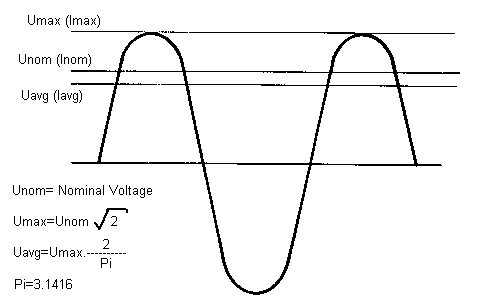
The first operation after the transformer is to convert the alternative voltage to a
direct one. Diodes do it.
Solid state diodes are not very good for high-fidelity purposes as they generate
"peaks" (fast impulsions) that pass through the circuits.
To reduce this, you can use "audio" diodes with much smaller peaks or bypass
each diode with a small capacitor, but it's difficult to avoid these peaks completely.
That's why tubes are still used in the best designs in the power supply too.
This schematic uses only one diode and though only one half of the sine wave. To fill the "gaps", the filtering should be twice to acheive the same results as a full-wave rectifier. It was used mainly in earlier designs.
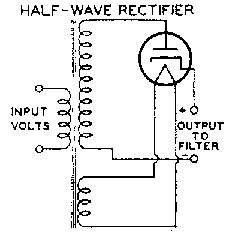
This schematic is, by far, the most used as it uses both the half-waves to produce DC.
Filtering is much easier.
You need two diodes or a bi-plate diode to acheive a full rectification.
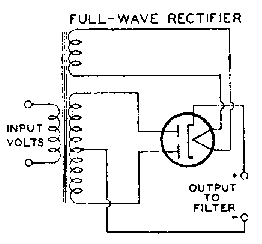
This schematic uses two diodes with their outputs serially connected to obtain a DC that is the double of its original AC voltage.
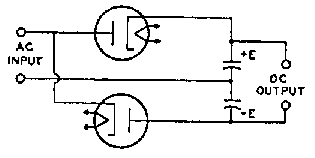
To "fill the gaps" of the DC coming from the diodes, you must filter it through various cells.
All the following formulas correspond to a full-wave rectifier. Filtering is much easier and effective in such configuration.
In such a configuration, the voltage will reach progressively (but quickly !) the Umax value. That's the reason why you should always use capacitors with a nominal voltage higher than the Umax.
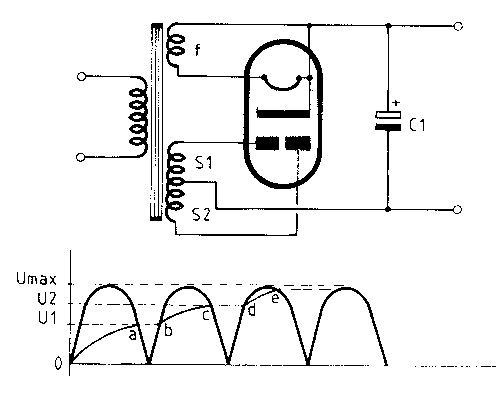
That's the simplest way to produce DC current. Pay attention to the value of the
capacitor: to large, it will destroy the diode by a high current appeal when powering ON
and some diodes (gas diodes) do not accept a capacitor at all, you should use a choke as
first element !
In this configuration the voltage never reaches Umax but varies between a minimum and a
maximum. The difference between these two voltages is the ripple, you can calculate it
with the following formula.
You can also easily understand why a bi-plaque diode is advantageous: the half sinewaves
are twice which results in a much lower ripple (2 times less: that's the "2" in
the formula) !
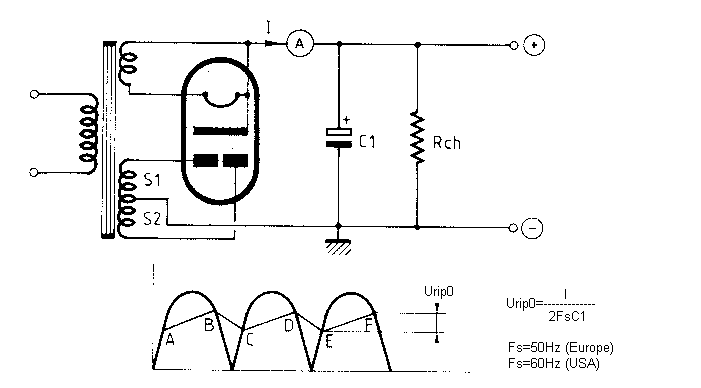
It's a common type and used very often.
It could be considered as a capacitor filter plus a self/capacitor filter.
The ripple will go down furthermore by a factor a1. W corresponds to the pulsation.
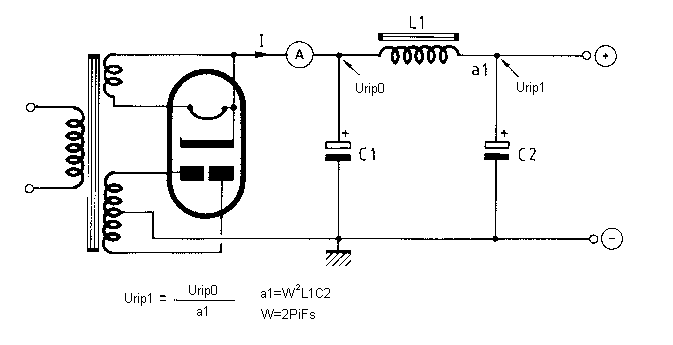
Each cell will reduce the ripple by its own factor (a1, a2, ...).
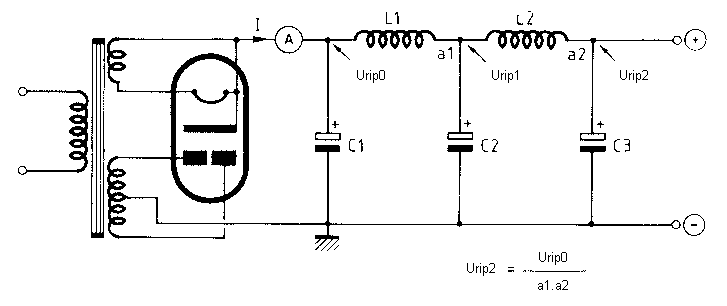
The choke is replaced by a resistor. This scheme is less effective than the choke one but still very useful in preamplifiers or other low current applications. For Amps, use selfs which let you have higher currents.

Each cell will reduce the ripple by its own factor (a1, a2, ...).
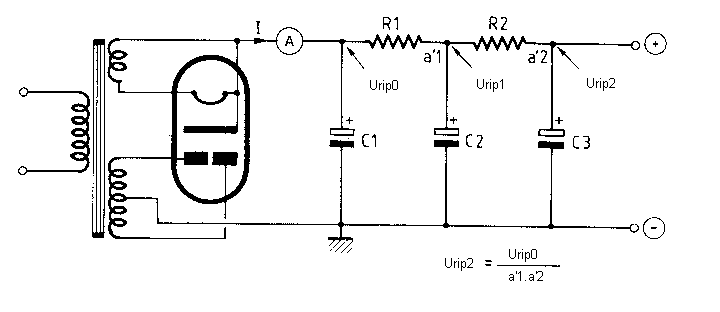
Of course you can mix selfs and resistors cells, each cell having its own ripple reducing factor.
It's sometimes difficult to find capacitors with high voltage specs. You can put 2 or more capacitors serially, their final capacitance will decrease:
1 1 1
----- = ----- + -----
Ctot C1 C2
For example: two 50uF/200V caps will results in a block of 25uF, but their voltage acceptance will increase to 400V.
A good thing is to put resistors (high values) in // with each capacitor to equilibrate the voltage that each capacitor will face.
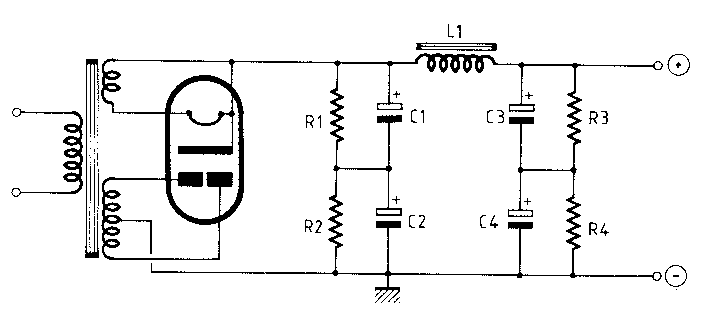
In the previous examples, only ripple was considered.
Another aspect should be considered: the amount of energy stored in the last supply stage.
This stage will furnish the instantaneous current to the power tubes.
As music is mainly composed by transients, it shouldn't be neglected.
the energy stored by a capacitor is calculated by:
![]()
where J = energy in Joules
C = capacity in Farads
V = voltage in Volts
1 Joule corresponds to the energy spent by a power of 1 Watt during 1 second.
To maintain a power of 10 Watts during 10 seconds, we need 100 Joules which means, for
a 500V supply, a capacity of 800uF.
But remember, this energy is given by such a cap fully discharged, thus with a final
voltage (the one supplying the power tubes !) down to 0 ...
The previous supply stages charge continuously these caps but nonetheless if we don't want
the supply to collapse, the final capacity should be much higher.
It's rarely the case in commercial products, mainly for costs reasons, and increasing the
size of the final caps is nearly always advisable.
Some comments about huge power supplies:
An example of such a philosophy is given for the Ampliton TS5000 and its "power pack".
The power supply should not only have an extremely low impedance but this impedance
should be frequency independent as much as possible.
Electrlytic caps allow huge capacities but present a serial resistance and inductance
higher than other non-polarized caps. This increases their impedance at high frequencies.
A usual technique to flatten this impedance is to bypass them with caps that do not have
such problems, unless for audio, like polypropylene caps.
To reduce the supply impedance, we should use, both for electrolytics and polypropylenes,
models with a high pulse current and high slew rate (Volts per microsecond: V/us).
The ideal would naturally be to use only fast non-polarized caps like polypropylens,
oiled paper, teflon, ... but it becomes very tricky to obtain a sufficient capacity to
respond to the demands of the final stage.
It should also be precised that power in music is located mainly in the lower part of the
spectrum, we can, in a multi-amplified system, use electrolytics only in the bass amp. The
med and high amps could use only fast and high-quality non-polarized caps.